The Ties that Bind (with Rawhide): Tefillin and LeatherJews
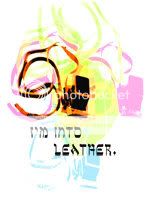
As with any and all fetishes, leather is not for everyone. We know that several of you are vegetarians and my not be into leather, so we have included some information at the end entry about non-leather alternatives.
-------
Just picture it, early morning, black leather straps binding and constricting your arm and head, fancy knot work and intricate weaving of the straps to heighten their importance. Then give praise to your ultimate Master, G-d.
Thats right, we are talking about Tefillin. For Jewish leather fetishists, Tefillin has not only a religious significance, but for some, it can be considered highly erotic. Traditionalist may be disturbed by the blending of sexuality and religious objects, but we hope you maintain an open mind.
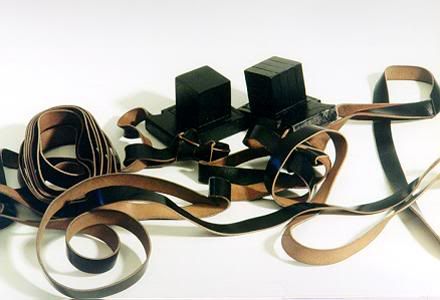
Recently there were some voices of outrage within the Jewish community about a photo exhibit called the Shekhina Project by none other than Leonard Nimoy (yes, of Star Trek by the way, Nimoy is a fellow Member of the Tribe). The collection of photos featured naked or semi-naked women many of who were adorned with Tefillin or Tallisim. Here are some pictures of the women wearing Tefillin.

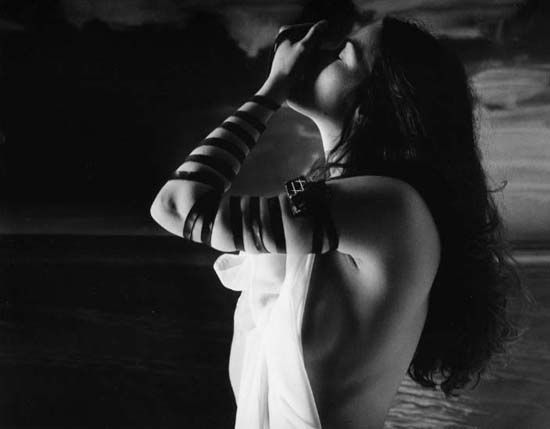
Next weeks feature will be on Tallisim (prayer shawls) and we will include some more of Nemoys photos at that time. If you want to see the full collection, see http://leonardnimoyphotography.com/2photoshekhina.htm.
So what exactly are Tefillin. We wanted to provide you a proper explanation, so weve hijacked this from Wikipedia, the free encyclopedia (you can scroll down if you already know all of this, as there is much more below this long explanation).
Tefillin, also called phylacteries, are leather objects containing Biblical verses which are used in rabbinic Jewish prayer. They are an essential part of morning prayer services, and are worn on a daily basis (except the Sabbath and festivals) by many Jews.

The origin of wearing tefillin stems from interpretations of passages found in the Torah (five books of Moses), in Deuteronomy 6:8, 11:18; Exodus 13:9, 16. While these passages were interpreted literally by most commentators (in contrast to the interpretation of Karaite Judaism, Abraham ibn Ezra, and Rashbam on Exodus 13:9), the Rabbis held that the general law only was expressed in the Bible, the application and elaboration of it being entirely matters of the oral law. The earlier tannaim (rabbis of the Mishnah) described their views of the tefillin in the Mishnah and Talmud. (Talmud references: Menachot 34b; Zeb. 37b; Sanhedrin 4b; Rashi and Tosafot ad loc. )
Details of Manufacture
Tefillin consist of two leather boxes, one worn on the arm and known as "shel yad", and the other worn on the head and known as "shel rosh". They are made of the skins of kosher animals.
According to traditional Jewish law, the boxes must be square; their height should be about the same length or the width; and they should be dyed black. The boxes are fastened on the under side with square pieces of thick leather by twelve stitches, and are provided with loops at the ends, through which are passed leather straps. They are blackened on the outside. The threads are prepared from the veins of kosher animals.
The strap that is passed through the head-tefillin ends at the back of the head in a knot representing the letter Daled; the one that is passed through the hand-tefillin is formed into a noose near the box and fastened in a knot in the shape of the letter Yood. The box containing the head-tefillin has on the outside the letter Shin, both to the right (with three strokes: Shin) and to the left; and this, together with the letters formed by the knots of the two straps, make up the letters of the Hebrew word Shaddai ("Almighty"), one of the names of God.
The measurements of the boxes are not given; but it is recommended that they should not be smaller than the width of two fingers. They should not be too big, either, because then they wouldn't lie evenly on the head (either the beginning or the end will be off the head). The width of the straps should be equal to the length of a grain of oats. The strap that is passed through the head-tefillin should be long enough to encircle the head and to allow for the knot. The two ends, falling in front over either shoulder, should reach the navel, or somewhat above it. The strap that is passed through the hand-tefillin should be long enough to allow for the knot, to encircle the whole length of the arm, and then to be wound three times around the middle finger.
Contents
Each box contains these Biblical passages: Exodus 13:1-10, 11-16; Deuteronomy 6:4-9, 11:13-21, written with black ink in Hebrew in Assyrian font on parchment specially prepared for the purpose, from the skin of a kosher animal.
Arrangement of Passages
The hand-tefillin has only one compartment, which contains the four Biblical selections written upon a single strip of parchment in four parallel columns and in the order given in the Bible. The head-tefillin has four compartments, formed from one piece of leather, in each of which one selection written on a separate piece of parchment is deposited perpendicularly.
The pieces of parchment on which the Biblical selections are written are in either case tied round with narrow strips of parchment and fastened with the thoroughly washed hair of a kosher animal, preferably of a calf. There was considerable discussion among the commentators of the Talmud as to the order in which the Biblical selections should be inserted into the head-phylactery. The chief disputants in this case were Rabbi Solomon Yitzhaki (Rashi) and Rabbi Jacob ben Mer Tam (Rabbenu Tam), although different possible arrangements have been suggested by other writers ("Shimmusha Rabba" and the Rabad).
The prevailing custom is to follow the opinion of Rashi. Some Sephardim and Hasidic Jews are accustomed, in order to be certain of performing their duty properly, to lay two pairs of tefillin; one pair is prepared in accordance with the view of Rashi, and the other pair in accordance with that of Rabbenu Tam. If, however, one is uncertain as to the exact position for two pairs of tefillin at the same time, one should first "lay" the tefillin prepared in accordance with Rashi's opinion, and then, removing these during the latter part of the service, without pronouncing a blessing lay those prepared in accordance with Rabbenu Tam's opinion.
Mode of Writing
The parchment on which the Biblical passages are written need not be ruled, although the custom is to rule it. A pointed instrument that leaves no blot should be used in ruling; the use of a pencil is forbidden. The scribe should be very careful in writing the selections. Before beginning to write he should pronounce the words, "I am writing this for the sake of the holiness of tefillin"; and before he begins to write any of the names of God occurring in the texts, he should say, "I am writing this for the sake of the holiness of the Name." Throughout the writing his attention must not be diverted; "even if the King of Israel should then greet him, he is forbidden to reply". Unlike a Sefer Torah but similar to a mezuzah, tefillin passages must be written in order or how it appears in the torah. Should the words be written out of sequence, the parchment is invalid and not kosher.
How the Tefillin is Worn
In putting on the tefillin, the hand-tefillin is laid first. Its place is on the inner side of the left arm, above the elbow,on the biceps, leveled to the heart, (fifth interspace of the ribcage and above).
Similarly the head-tefillin is worn above the hairline); and it is held in position by the noose of the strap.
When the arm hangs the tefillin must rest near the heart.
People who write with their left hand wear the Tefillin on the right arm.
After the tefillin is thus fastened on the bare arm, the strap is wound seven times round the arm.
The head tefillin is placed so as to overhang the middle of the forehead, although it may not be lower than one's hairline, with the knot of the strap at the back of the head and overhanging the middle of the neck, while the two ends of the strap, with the blackened side outward, hang over the shoulders in front.
On laying the hand-tefillin, before the knot is fastened, the following benediction is pronounced: "Blessed are you, Lord, our God, King of the universe, Who has sanctified us with His commandments and has commanded us to put on tefillin."
Transliteration: Baruch Atah Adonai, elohainu, melech haolam, asher kidshanu b'mitzvotav v'tzivanu l'haniach t'fillin.
Then the arm tefillin is tightend, and wrapped around the arm seven times without interruption and immediately place the head one. On placement of the head tefillin, nothing is said unless one talked or interrupted by mistake, so the following is recited: "Blessed are you, Lord, our God, King of the universe, Who has sanctified us with His commandments and has commanded us regarding the commandment of tefillin."
Transliteration: Baruch Atah Adonai, elohainu, melech haolam, asher kidshanu b'mitzvotav v'tzivanu al mitzvat t'fillin.
And then the head tefillin is tightened, as the following prayer is said: "Blessed is the Name of His glorious kingdom for ever and ever."
Transliteration: Baruch Shem kevod malkhuto l'olam vaed.

The Blessings
Before the head-tefillin is fastened, many repeat the blessing with the substitution of the phrase "concerning the commandment of tefillin" for "to lay tefillin." Some authorities are of the opinion that the blessing on laying the head-tefillin should be pronounced only when an interruption has occurred through conversation on the part of the one engaged in performing the commandment; otherwise the one blessing pronounced on laying the hand-tefillin is sufficient. This is the current Sephardi custom. The prevailing custom amongst Ashkenazim is to pronounce two blessings, and, after the second blessing, to say the words, "Blessed be the name of God's glorious kingdom for ever and ever," lest the second benediction be pronounced unnecessarily.
Amongst Ashkenazim, the strap of the hand-phylactery is then wound three times around the middle finger so as to form a Shin and the passages Hosea ii. 21 and 22 are recited. After the tefillin are laid Exodus xiii. 1-16 is recited. In removing the tefillin the three twistings on the middle finger are loosened first; then the head-phylactery is removed; and finally the hand-phylactery. It is customary to lay and to remove the tefillin while standing; also to kiss them when they are taken from and returned to the tefillin-bag.
Sephardim proceed similarly, but often without the extra scriptural passages, and the shape Daled is shaped on the palm of the hand and the shape of a Shin is formed around the middle finger, so as to represent the name Shaddai from the middle finger (Shin) through the palm (Daled) to the short extra strap of leather (Yood) hanging from the bayit (box) of the hand-phylactery.
Originally tefillin were worn all day, but not during the night. Now the prevailing custom is to wear them during the daily morning service only. They are not worn on Sabbaths and holy days; for these, being in themselves "signs," render the tefillin, which are to serve as signs themselves (Ex. xiii. 9, 16), unnecessary. In those places where tefillin are worn on the week-days of the festivals (see Holy Days), and on New Moons, they are removed before the "Musaf" prayer.
Women and tefillin
The duty of laying tefillin rests upon males after the age of thirteen years and one day. Women are exempt from the obligation, as are also slaves and minors. Early Jewish law codes allow women to take on the obligation of wearing tefillin (Rashi's daughters wore tefillin, and so did Michal, the daughter of King Saul and the wife of King David), but this custom was generally discouraged. Over time the discouragement changed into active exclusion, especially amongst Ashkenazim: Later codes of Jewish law such as the Shulhan Arukh eventually forbade women from wearing tefillin at all.
Traditional Sephardi authorities who permitted - and encouraged - women's use of tefillin after the Shulhan Arukh were the 18th Century chief rabbis of Jerusalem R. Yisrael Ya'aqob Alghazi and his son R. Yomtob Alghazi.
Modern Orthodox Judaism holds that it is permissible for women to wear tefillin, but generally discourage it. Conservative Judaism and Reform Judaism allow women to wear tefillin. Many in Conservative Judaism encourage this practice.
Prohibitions
An Onein (mourner from the time of death until the time of burial), a bridegroom on his wedding-day, one who has been excommunicated, and a m'tzora are exempt from wearing tefillin (In modern times, the mourner mentioned above would not wear tefillin, but a bridegroom does. The other two individuals no longer exist). A sufferer from stomach-trouble, one who is otherwise in pain and can not concentrate his mind, one who is engaged in the study of the Law, and scribes of and dealers in tefillin and mezuzot while engaged in their work if it can not be postponed, are also free from this obligation). It is not permitted to enter a cemetery or any unseemly place, or to eat a regular meal or to sleep, while wearing tefillin. The storage bag used for tefillin should not be used for any other purpose, unless a condition was expressly made that it might be used for any purpose. The tefillin should not be brought into a restroom. Ideally, this rule should be followed with regard to the tefillin in their storage bag.
In his Mishneh Torah, Maimonides concludes the laws of tefillin with the following exhortation :
"The sanctity of tefillin is very great. As long as the tefillin are on the head and on the arm of a man, he is modest and God-fearing and will not be attracted by hilarity or idle talk, and will have no evil thoughts, but will devote all his thoughts to truth and righteousness; Therefore, every man ought to try to have the tefillin upon him the whole day; for only in this way can he fulfil the commandment. It is related that Rav (Abba Arika), the pupil of our holy teacher (Rav Judah ha-Nasi), was never seen to walk four cubits without a Torah, without fringes on his garments (tzitzit), and without tefillin. Although the Law enjoins the wearing of tefillin the whole day, it is especially commendable to wear them during prayer. The sages say that one who reads the Shema' without tefillin is as if he testified falsely against himself. He who does not lay tefillin transgresses eight commandments; for in each of the four Biblical passages there is a commandment to wear tefillin on the head and on the arm. But he who is accustomed to wear tefillin will live long, as it is written, 'When the Lord is upon them they will live'".
Name and Origin
The only instance of the name "phylacteries" in Biblical times occurs in the New Testament (Matthew xxiii. 5), whence it has passed into the languages of Europe. In rabbinic literature it is not found even as a foreign word. The Septuagint renders ".. scrupulously pious persons put on the tefillin of R. Tam after prayer. There were differences of opinion between the Spanish and the German Jews in regard to the knot in the strap (see illustrations in Surenhusius, cited below).
Other people beyond Leonard Nemoy have combined leather fetishes with Judaism.

The group, LeatherJews, stands out the most. They have a website at http://mchester.queernet.org/leatherjews and a livejournal at http://www.livejournal.com/community/leatherjews.
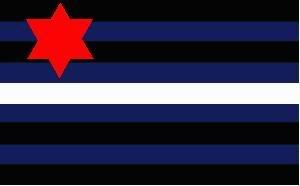

Their coordinator led a seminar at Horizons 2000: the 16th World Conference of GLBT Jews in 2000, entitled, "LeatherJews: GLBT Jews in the World of Leather, BDSM, and other Radical Sexualities". The Horizons conference is held every couple of years, sponsored by The World Congress of Gay, Lesbian, Bisexual, and Transgender Jews: Keshet Ga'avah and a local organization, in this case New Jersey's Lesbian & Gay Havurah.
At least 30 men and women attended the seminar, and they were a mix of heavily-in-the-scene, mostly-vanilla-but-do-some-play, seriously-curious-about-exploring-the-scene, just-curious, and interested-in-understanding-friends-congregants-lovers etc.
LeatherJews website has a photo shoot by Mark I. Chester of a Leather Shabbat.
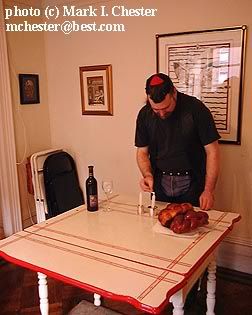
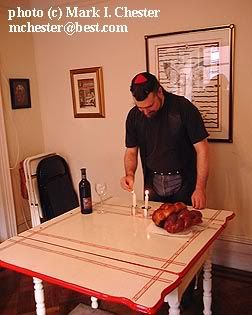
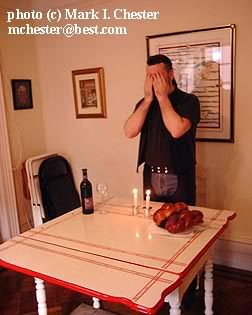

Mark also has a powerful piece involving Tefillin.
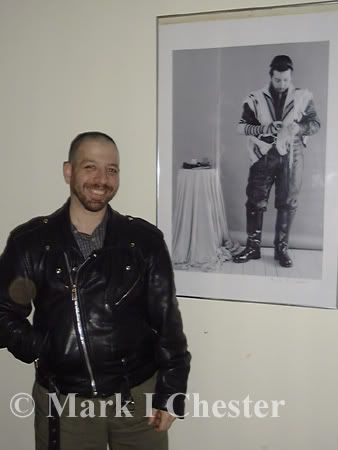
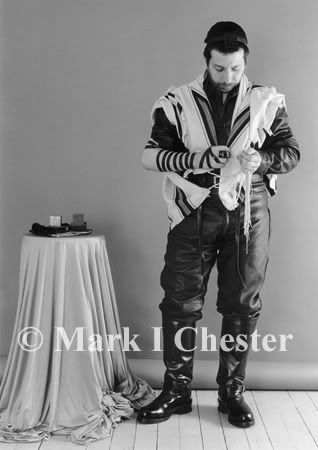
Marks work can be seen on his website at
http://mchester.best.vwh.net.
There are others that combine leather and Judaism in interesting ways. Take for example, the King David Bikers. They are not fetishists, but I bet most Leather Jews would quite like them.

This is what the King David Bikers says about themselves.

A New Club is Rolling Into Town
A new congregation is rolling into South Florida and it has less to do with whether you are a conservative, reform or orthodox Jew than it does with whether or not you ride a motorcycle. If you are Jewish and you ride a motorcycle, finally theres an organization for you - King David Bikers (KDB).

Respect Honor Religion The Road
As Jews we honor and respect the Lord and as motorcycle enthusiasts, we honor our bikes and respect the road, says the groups big macha and founder, Jeff Mustard, who rides a 1600 cc Yamaha Road Star. Says Mustard, For the first time, motorcycle enthusiasts of the Jewish faith in South Florida can congregate to share their love of motorcycles, their passion for riding and their desire to meet other Jews who feel the same way about their bikes, their religion and the ride.
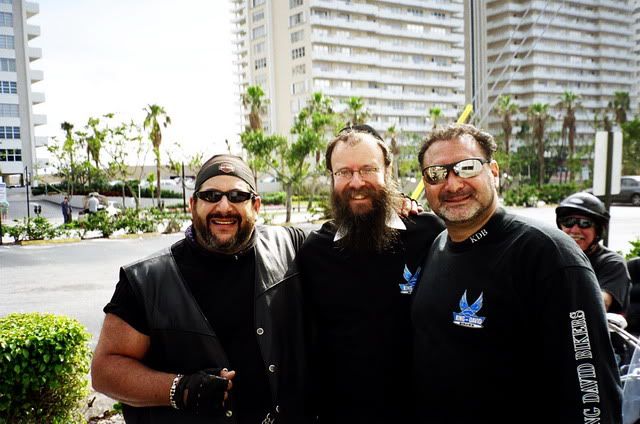
Jewish Needs
After I got my bike, I was looking for a club and didnt feel there was one that met my needs, says Jeff Mustard. What are Mustards needs? Look, Im Jewish, Im a professional, I ride a nice bike, I like to dress well and eat good food. Mustard is a writer/producer and the Director of Communications for a Boca Raton-based international investment banking company.
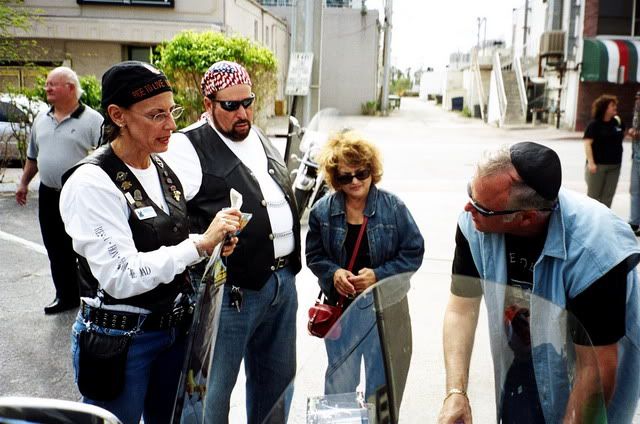
Our Members
What compelled Mustard to start King David Bikers? Says Mustard, I found that membership into most clubs is predicated simply on the kind of bike you own, just because I own the same brand bike as someone doesnt mean I necessarily want to hang out with that person or group.

Our Philosophy
King David Bikers has no restrictions, it is open to men and women of all ages, couples, singles and it doesnt matter what you ride. Cruisers and sport bikes are welcome. The only thing that counts is your passion to ride and your faith as a Jew. In the spirit of the Jewish faith KDB will support various Jewish charities, causes and organizations. From time to time there may be non-denominational rides.
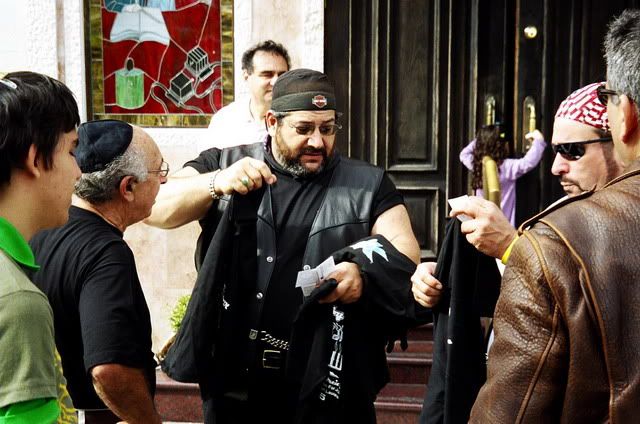
Eat Something, Youll Feel Better
The difference between the KDB and other clubs is that membership will replicate the Jewish lifestyle, meaning mostly every ride will revolve around food, as opposed to alcohol, as is often the case with other club rides. As Jews, we must be the hungriest people in the world, we barely finish a meal and were wondering what were gonna eat next; what better excuse than to ride somewhere on your bike and get something to eat.
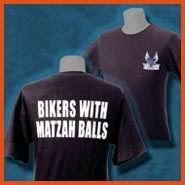
All Dressed Up With Somewhere to Go
Participating in KDB doesnt require your fanciest suit or your prettiest dress, just your snappiest riding gear. If you and your bike are all dressed up with nowhere to go, King David Bikers is for you. According to the club prez, Mustard, you can ride alone, which is great, but riding with a buddy or a group is even better.

Madonna, we mean Esther, recently wore Tefillin one of her music video, who some people liked and others found distasteful. As mentioned above there are some people who form associations between Tefillin and Kabbalah, Madonnas religion de jour.

Women who wear Tefillin made up this poster.

Tefillin is not the only thing that is crosses leather and Judaism. Take for example this s&m kippah.
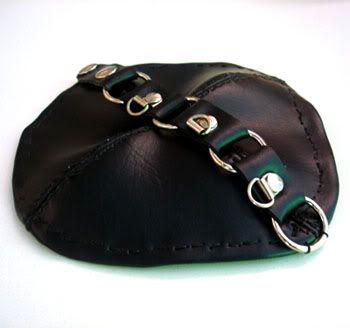
And many books are also leather bound.
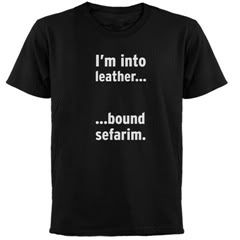
-------
Now as promised, for the non-leather folks, there is are some alternatives when it comes to kink. Check out the Veg Sex Shop at https://vegsexshop.com and Vegan Erotica at http://www.veganerotica.com.


Unfortunately there are very few non-leather tefillin out there that we know of. We know they would not be properly kosher, but still, some people would be interested.
We found these online:

at http://www.zipporahreshel.com/Merchant2/merchant.mvc?Screen=PROD&Store_Code=001&Product_Code=4401&Category_Code=000001.
If anyone knows anywhere else people can buy other types of non-leather/non-parchment tefillin, let us know.
We welcome any feedback you might have.

As with any and all fetishes, leather is not for everyone. We know that several of you are vegetarians and my not be into leather, so we have included some information at the end entry about non-leather alternatives.
-------
Just picture it, early morning, black leather straps binding and constricting your arm and head, fancy knot work and intricate weaving of the straps to heighten their importance. Then give praise to your ultimate Master, G-d.
Thats right, we are talking about Tefillin. For Jewish leather fetishists, Tefillin has not only a religious significance, but for some, it can be considered highly erotic. Traditionalist may be disturbed by the blending of sexuality and religious objects, but we hope you maintain an open mind.

Recently there were some voices of outrage within the Jewish community about a photo exhibit called the Shekhina Project by none other than Leonard Nimoy (yes, of Star Trek by the way, Nimoy is a fellow Member of the Tribe). The collection of photos featured naked or semi-naked women many of who were adorned with Tefillin or Tallisim. Here are some pictures of the women wearing Tefillin.


Next weeks feature will be on Tallisim (prayer shawls) and we will include some more of Nemoys photos at that time. If you want to see the full collection, see http://leonardnimoyphotography.com/2photoshekhina.htm.
So what exactly are Tefillin. We wanted to provide you a proper explanation, so weve hijacked this from Wikipedia, the free encyclopedia (you can scroll down if you already know all of this, as there is much more below this long explanation).
Tefillin, also called phylacteries, are leather objects containing Biblical verses which are used in rabbinic Jewish prayer. They are an essential part of morning prayer services, and are worn on a daily basis (except the Sabbath and festivals) by many Jews.

The origin of wearing tefillin stems from interpretations of passages found in the Torah (five books of Moses), in Deuteronomy 6:8, 11:18; Exodus 13:9, 16. While these passages were interpreted literally by most commentators (in contrast to the interpretation of Karaite Judaism, Abraham ibn Ezra, and Rashbam on Exodus 13:9), the Rabbis held that the general law only was expressed in the Bible, the application and elaboration of it being entirely matters of the oral law. The earlier tannaim (rabbis of the Mishnah) described their views of the tefillin in the Mishnah and Talmud. (Talmud references: Menachot 34b; Zeb. 37b; Sanhedrin 4b; Rashi and Tosafot ad loc. )
Details of Manufacture
Tefillin consist of two leather boxes, one worn on the arm and known as "shel yad", and the other worn on the head and known as "shel rosh". They are made of the skins of kosher animals.
According to traditional Jewish law, the boxes must be square; their height should be about the same length or the width; and they should be dyed black. The boxes are fastened on the under side with square pieces of thick leather by twelve stitches, and are provided with loops at the ends, through which are passed leather straps. They are blackened on the outside. The threads are prepared from the veins of kosher animals.
The strap that is passed through the head-tefillin ends at the back of the head in a knot representing the letter Daled; the one that is passed through the hand-tefillin is formed into a noose near the box and fastened in a knot in the shape of the letter Yood. The box containing the head-tefillin has on the outside the letter Shin, both to the right (with three strokes: Shin) and to the left; and this, together with the letters formed by the knots of the two straps, make up the letters of the Hebrew word Shaddai ("Almighty"), one of the names of God.
The measurements of the boxes are not given; but it is recommended that they should not be smaller than the width of two fingers. They should not be too big, either, because then they wouldn't lie evenly on the head (either the beginning or the end will be off the head). The width of the straps should be equal to the length of a grain of oats. The strap that is passed through the head-tefillin should be long enough to encircle the head and to allow for the knot. The two ends, falling in front over either shoulder, should reach the navel, or somewhat above it. The strap that is passed through the hand-tefillin should be long enough to allow for the knot, to encircle the whole length of the arm, and then to be wound three times around the middle finger.
Contents
Each box contains these Biblical passages: Exodus 13:1-10, 11-16; Deuteronomy 6:4-9, 11:13-21, written with black ink in Hebrew in Assyrian font on parchment specially prepared for the purpose, from the skin of a kosher animal.
Arrangement of Passages
The hand-tefillin has only one compartment, which contains the four Biblical selections written upon a single strip of parchment in four parallel columns and in the order given in the Bible. The head-tefillin has four compartments, formed from one piece of leather, in each of which one selection written on a separate piece of parchment is deposited perpendicularly.
The pieces of parchment on which the Biblical selections are written are in either case tied round with narrow strips of parchment and fastened with the thoroughly washed hair of a kosher animal, preferably of a calf. There was considerable discussion among the commentators of the Talmud as to the order in which the Biblical selections should be inserted into the head-phylactery. The chief disputants in this case were Rabbi Solomon Yitzhaki (Rashi) and Rabbi Jacob ben Mer Tam (Rabbenu Tam), although different possible arrangements have been suggested by other writers ("Shimmusha Rabba" and the Rabad).
The prevailing custom is to follow the opinion of Rashi. Some Sephardim and Hasidic Jews are accustomed, in order to be certain of performing their duty properly, to lay two pairs of tefillin; one pair is prepared in accordance with the view of Rashi, and the other pair in accordance with that of Rabbenu Tam. If, however, one is uncertain as to the exact position for two pairs of tefillin at the same time, one should first "lay" the tefillin prepared in accordance with Rashi's opinion, and then, removing these during the latter part of the service, without pronouncing a blessing lay those prepared in accordance with Rabbenu Tam's opinion.
Mode of Writing
The parchment on which the Biblical passages are written need not be ruled, although the custom is to rule it. A pointed instrument that leaves no blot should be used in ruling; the use of a pencil is forbidden. The scribe should be very careful in writing the selections. Before beginning to write he should pronounce the words, "I am writing this for the sake of the holiness of tefillin"; and before he begins to write any of the names of God occurring in the texts, he should say, "I am writing this for the sake of the holiness of the Name." Throughout the writing his attention must not be diverted; "even if the King of Israel should then greet him, he is forbidden to reply". Unlike a Sefer Torah but similar to a mezuzah, tefillin passages must be written in order or how it appears in the torah. Should the words be written out of sequence, the parchment is invalid and not kosher.
How the Tefillin is Worn
In putting on the tefillin, the hand-tefillin is laid first. Its place is on the inner side of the left arm, above the elbow,on the biceps, leveled to the heart, (fifth interspace of the ribcage and above).
Similarly the head-tefillin is worn above the hairline); and it is held in position by the noose of the strap.
When the arm hangs the tefillin must rest near the heart.
People who write with their left hand wear the Tefillin on the right arm.
After the tefillin is thus fastened on the bare arm, the strap is wound seven times round the arm.
The head tefillin is placed so as to overhang the middle of the forehead, although it may not be lower than one's hairline, with the knot of the strap at the back of the head and overhanging the middle of the neck, while the two ends of the strap, with the blackened side outward, hang over the shoulders in front.
On laying the hand-tefillin, before the knot is fastened, the following benediction is pronounced: "Blessed are you, Lord, our God, King of the universe, Who has sanctified us with His commandments and has commanded us to put on tefillin."
Transliteration: Baruch Atah Adonai, elohainu, melech haolam, asher kidshanu b'mitzvotav v'tzivanu l'haniach t'fillin.
Then the arm tefillin is tightend, and wrapped around the arm seven times without interruption and immediately place the head one. On placement of the head tefillin, nothing is said unless one talked or interrupted by mistake, so the following is recited: "Blessed are you, Lord, our God, King of the universe, Who has sanctified us with His commandments and has commanded us regarding the commandment of tefillin."
Transliteration: Baruch Atah Adonai, elohainu, melech haolam, asher kidshanu b'mitzvotav v'tzivanu al mitzvat t'fillin.
And then the head tefillin is tightened, as the following prayer is said: "Blessed is the Name of His glorious kingdom for ever and ever."
Transliteration: Baruch Shem kevod malkhuto l'olam vaed.

The Blessings
Before the head-tefillin is fastened, many repeat the blessing with the substitution of the phrase "concerning the commandment of tefillin" for "to lay tefillin." Some authorities are of the opinion that the blessing on laying the head-tefillin should be pronounced only when an interruption has occurred through conversation on the part of the one engaged in performing the commandment; otherwise the one blessing pronounced on laying the hand-tefillin is sufficient. This is the current Sephardi custom. The prevailing custom amongst Ashkenazim is to pronounce two blessings, and, after the second blessing, to say the words, "Blessed be the name of God's glorious kingdom for ever and ever," lest the second benediction be pronounced unnecessarily.
Amongst Ashkenazim, the strap of the hand-phylactery is then wound three times around the middle finger so as to form a Shin and the passages Hosea ii. 21 and 22 are recited. After the tefillin are laid Exodus xiii. 1-16 is recited. In removing the tefillin the three twistings on the middle finger are loosened first; then the head-phylactery is removed; and finally the hand-phylactery. It is customary to lay and to remove the tefillin while standing; also to kiss them when they are taken from and returned to the tefillin-bag.
Sephardim proceed similarly, but often without the extra scriptural passages, and the shape Daled is shaped on the palm of the hand and the shape of a Shin is formed around the middle finger, so as to represent the name Shaddai from the middle finger (Shin) through the palm (Daled) to the short extra strap of leather (Yood) hanging from the bayit (box) of the hand-phylactery.
Originally tefillin were worn all day, but not during the night. Now the prevailing custom is to wear them during the daily morning service only. They are not worn on Sabbaths and holy days; for these, being in themselves "signs," render the tefillin, which are to serve as signs themselves (Ex. xiii. 9, 16), unnecessary. In those places where tefillin are worn on the week-days of the festivals (see Holy Days), and on New Moons, they are removed before the "Musaf" prayer.
Women and tefillin
The duty of laying tefillin rests upon males after the age of thirteen years and one day. Women are exempt from the obligation, as are also slaves and minors. Early Jewish law codes allow women to take on the obligation of wearing tefillin (Rashi's daughters wore tefillin, and so did Michal, the daughter of King Saul and the wife of King David), but this custom was generally discouraged. Over time the discouragement changed into active exclusion, especially amongst Ashkenazim: Later codes of Jewish law such as the Shulhan Arukh eventually forbade women from wearing tefillin at all.
Traditional Sephardi authorities who permitted - and encouraged - women's use of tefillin after the Shulhan Arukh were the 18th Century chief rabbis of Jerusalem R. Yisrael Ya'aqob Alghazi and his son R. Yomtob Alghazi.
Modern Orthodox Judaism holds that it is permissible for women to wear tefillin, but generally discourage it. Conservative Judaism and Reform Judaism allow women to wear tefillin. Many in Conservative Judaism encourage this practice.
Prohibitions
An Onein (mourner from the time of death until the time of burial), a bridegroom on his wedding-day, one who has been excommunicated, and a m'tzora are exempt from wearing tefillin (In modern times, the mourner mentioned above would not wear tefillin, but a bridegroom does. The other two individuals no longer exist). A sufferer from stomach-trouble, one who is otherwise in pain and can not concentrate his mind, one who is engaged in the study of the Law, and scribes of and dealers in tefillin and mezuzot while engaged in their work if it can not be postponed, are also free from this obligation). It is not permitted to enter a cemetery or any unseemly place, or to eat a regular meal or to sleep, while wearing tefillin. The storage bag used for tefillin should not be used for any other purpose, unless a condition was expressly made that it might be used for any purpose. The tefillin should not be brought into a restroom. Ideally, this rule should be followed with regard to the tefillin in their storage bag.
In his Mishneh Torah, Maimonides concludes the laws of tefillin with the following exhortation :
"The sanctity of tefillin is very great. As long as the tefillin are on the head and on the arm of a man, he is modest and God-fearing and will not be attracted by hilarity or idle talk, and will have no evil thoughts, but will devote all his thoughts to truth and righteousness; Therefore, every man ought to try to have the tefillin upon him the whole day; for only in this way can he fulfil the commandment. It is related that Rav (Abba Arika), the pupil of our holy teacher (Rav Judah ha-Nasi), was never seen to walk four cubits without a Torah, without fringes on his garments (tzitzit), and without tefillin. Although the Law enjoins the wearing of tefillin the whole day, it is especially commendable to wear them during prayer. The sages say that one who reads the Shema' without tefillin is as if he testified falsely against himself. He who does not lay tefillin transgresses eight commandments; for in each of the four Biblical passages there is a commandment to wear tefillin on the head and on the arm. But he who is accustomed to wear tefillin will live long, as it is written, 'When the Lord is upon them they will live'".
Name and Origin
The only instance of the name "phylacteries" in Biblical times occurs in the New Testament (Matthew xxiii. 5), whence it has passed into the languages of Europe. In rabbinic literature it is not found even as a foreign word. The Septuagint renders ".. scrupulously pious persons put on the tefillin of R. Tam after prayer. There were differences of opinion between the Spanish and the German Jews in regard to the knot in the strap (see illustrations in Surenhusius, cited below).
Other people beyond Leonard Nemoy have combined leather fetishes with Judaism.

The group, LeatherJews, stands out the most. They have a website at http://mchester.queernet.org/leatherjews and a livejournal at http://www.livejournal.com/community/leatherjews.


Their coordinator led a seminar at Horizons 2000: the 16th World Conference of GLBT Jews in 2000, entitled, "LeatherJews: GLBT Jews in the World of Leather, BDSM, and other Radical Sexualities". The Horizons conference is held every couple of years, sponsored by The World Congress of Gay, Lesbian, Bisexual, and Transgender Jews: Keshet Ga'avah and a local organization, in this case New Jersey's Lesbian & Gay Havurah.
At least 30 men and women attended the seminar, and they were a mix of heavily-in-the-scene, mostly-vanilla-but-do-some-play, seriously-curious-about-exploring-the-scene, just-curious, and interested-in-understanding-friends-congregants-lovers etc.
LeatherJews website has a photo shoot by Mark I. Chester of a Leather Shabbat.




Mark also has a powerful piece involving Tefillin.


Marks work can be seen on his website at
http://mchester.best.vwh.net.
There are others that combine leather and Judaism in interesting ways. Take for example, the King David Bikers. They are not fetishists, but I bet most Leather Jews would quite like them.

This is what the King David Bikers says about themselves.

A New Club is Rolling Into Town
A new congregation is rolling into South Florida and it has less to do with whether you are a conservative, reform or orthodox Jew than it does with whether or not you ride a motorcycle. If you are Jewish and you ride a motorcycle, finally theres an organization for you - King David Bikers (KDB).

Respect Honor Religion The Road
As Jews we honor and respect the Lord and as motorcycle enthusiasts, we honor our bikes and respect the road, says the groups big macha and founder, Jeff Mustard, who rides a 1600 cc Yamaha Road Star. Says Mustard, For the first time, motorcycle enthusiasts of the Jewish faith in South Florida can congregate to share their love of motorcycles, their passion for riding and their desire to meet other Jews who feel the same way about their bikes, their religion and the ride.

Jewish Needs
After I got my bike, I was looking for a club and didnt feel there was one that met my needs, says Jeff Mustard. What are Mustards needs? Look, Im Jewish, Im a professional, I ride a nice bike, I like to dress well and eat good food. Mustard is a writer/producer and the Director of Communications for a Boca Raton-based international investment banking company.

Our Members
What compelled Mustard to start King David Bikers? Says Mustard, I found that membership into most clubs is predicated simply on the kind of bike you own, just because I own the same brand bike as someone doesnt mean I necessarily want to hang out with that person or group.

Our Philosophy
King David Bikers has no restrictions, it is open to men and women of all ages, couples, singles and it doesnt matter what you ride. Cruisers and sport bikes are welcome. The only thing that counts is your passion to ride and your faith as a Jew. In the spirit of the Jewish faith KDB will support various Jewish charities, causes and organizations. From time to time there may be non-denominational rides.

Eat Something, Youll Feel Better
The difference between the KDB and other clubs is that membership will replicate the Jewish lifestyle, meaning mostly every ride will revolve around food, as opposed to alcohol, as is often the case with other club rides. As Jews, we must be the hungriest people in the world, we barely finish a meal and were wondering what were gonna eat next; what better excuse than to ride somewhere on your bike and get something to eat.

All Dressed Up With Somewhere to Go
Participating in KDB doesnt require your fanciest suit or your prettiest dress, just your snappiest riding gear. If you and your bike are all dressed up with nowhere to go, King David Bikers is for you. According to the club prez, Mustard, you can ride alone, which is great, but riding with a buddy or a group is even better.

Madonna, we mean Esther, recently wore Tefillin one of her music video, who some people liked and others found distasteful. As mentioned above there are some people who form associations between Tefillin and Kabbalah, Madonnas religion de jour.

Women who wear Tefillin made up this poster.

Tefillin is not the only thing that is crosses leather and Judaism. Take for example this s&m kippah.

And many books are also leather bound.

-------
Now as promised, for the non-leather folks, there is are some alternatives when it comes to kink. Check out the Veg Sex Shop at https://vegsexshop.com and Vegan Erotica at http://www.veganerotica.com.


Unfortunately there are very few non-leather tefillin out there that we know of. We know they would not be properly kosher, but still, some people would be interested.
We found these online:

at http://www.zipporahreshel.com/Merchant2/merchant.mvc?Screen=PROD&Store_Code=001&Product_Code=4401&Category_Code=000001.
If anyone knows anywhere else people can buy other types of non-leather/non-parchment tefillin, let us know.
We welcome any feedback you might have.
VIEW 8 of 8 COMMENTS
Schicksal
[Edited on Mar 18, 2006 9:35PM]